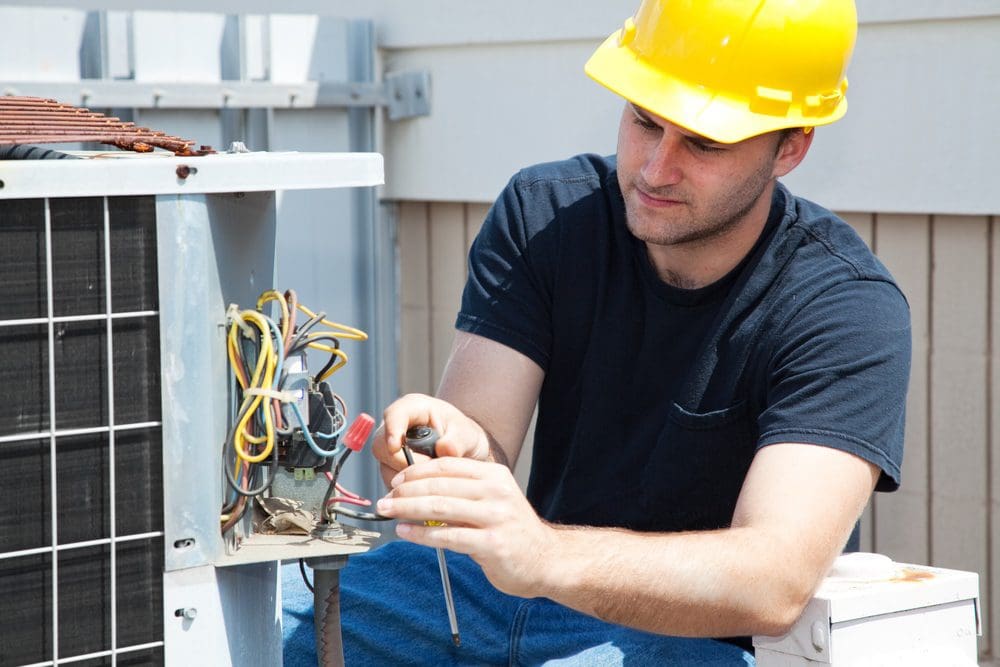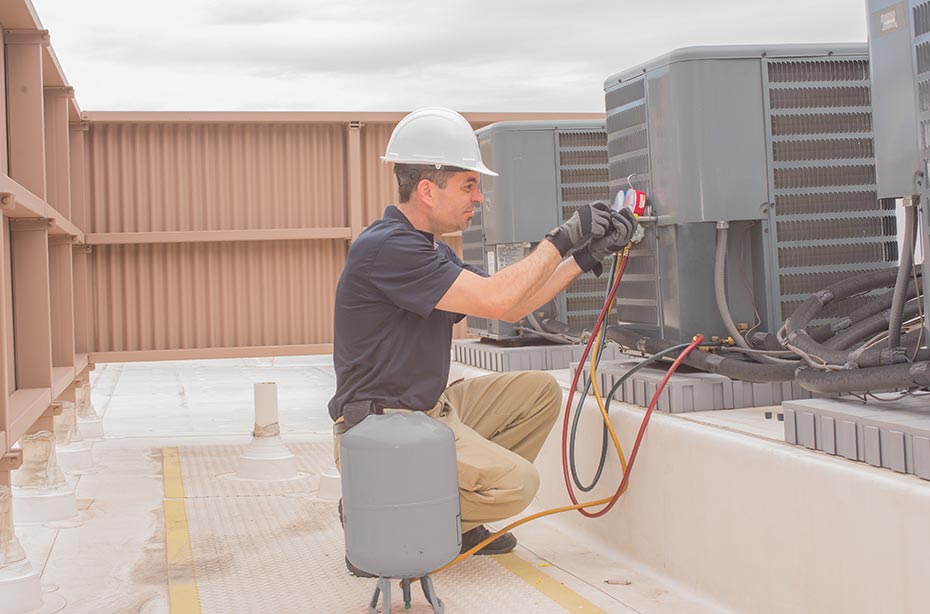How a Heatpump and Heating System Interact to Enhance Your Home's Heating Performance
Recognizing exactly how a heatpump and furnace collaborate is crucial for homeowners looking for efficient home heating options. Each system has its staminas, offering a well balanced method to home comfort. The warmth pump masters modest temperatures, while the furnace supplies rapid heat during extreme cold. This synergy not just minimizes energy costs yet also boosts the life expectancy of both devices. What elements influence this cooperation, and exactly how can homeowners optimize their benefits?
Comprehending Warmth Pumps: Exactly How They Work
Several people might be unknown with their internal operations, heat pumps play an important duty in modern heating systems. These tools run by transferring warmth from one location to another, using the concepts of thermodynamics. In colder months, a heatpump removes warm from the outdoors air, ground, or water, and transfers it inside to heat the space. Conversely, throughout warmer months, it can turn around the procedure, functioning as an a/c by getting rid of heat from inside to the outside.Heat pumps include an evaporator, condenser, development, and compressor valve. The refrigerant within the system absorbs warm as it vaporizes at reduced temperature levels and stress. The compressor then boosts the stress and temperature level of the cooling agent, enabling it to launch warm as it condenses. This effective process can substantially reduce energy consumption contrasted to standard home heating approaches, making warmth pumps a lasting option for environment control in homes.
The Role of Furnaces in Home Home Heating
Heaters play a vital function in home heating by providing a reliable source of heat throughout the cooler months. They run by creating warm through burning or electrical resistance, dispersing it throughout the home by means of air ducts or glowing systems. The performance of a heating system is commonly gauged by its Annual Gas Use Efficiency (AFUE) ranking, which shows just how efficiently the unit converts gas right into heat.Furnaces can make use of different energy resources, including natural gas, electrical power, gas, or oil, allowing home owners to select the most ideal choice for their demands. Unlike heat pumps, which might have a hard time in severe chilly, heating systems preserve regular performance, making certain that interior temperatures stay comfy regardless of outside problems. Furthermore, modern-day furnaces often come outfitted with sophisticated modern technology, such as variable-speed blowers and wise thermostats, improving their performance and responsiveness. This versatility makes heating systems an essential element in comprehensive home heating strategies.

Advantages of Utilizing Both Solutions Together
Combining the strengths of both furnaces and heat pumps can bring about an extra reliable and reliable home heating remedy. Utilizing both systems enables house owners to make the most of the warm pump's power performance throughout milder temperatures while relying upon the heater for more severe cold problems. This dual method can substantially reduce power costs, as warm pumps take in less electrical energy than conventional heating methods when temperatures are moderate.Additionally, using both systems with each other can boost comfort levels in the home. Heatpump can give constant, also heating, while heaters can promptly raise ambient temperature levels when needed. The combination of both systems can expand the life expectancy of equipment by minimizing wear and tear on each device, as they share the workload. Eventually, homeowners can take pleasure in a well balanced, cost-effective home heating solution that changes flawlessly to differing weather, making sure a cozy and welcoming home throughout the cold weather.
How Warm Pumps and Furnaces Enhance Each Other
They produce a complementary home heating system that makes best use of performance and comfort when property owners integrate heat pumps and furnaces. Warm pumps operate by transferring warm from the outside air or ground, making them extremely effective in modest environments. They stand out during milder temperature levels, providing cost-efficient heating. Conversely, heating systems produce warm via burning or electrical resistance, providing strong, prompt heat throughout extreme cold conditions.The combination of these two systems permits dynamic modifications based on temperature fluctuations. During warmer months or milder winter days, the heat pump can take the lead, conserving power and lowering prices. As temperatures drop, the furnace can seamlessly involve, making sure regular heat throughout the home. This synergy not just maximizes power use but additionally boosts the lifespan of both systems, as each device operates within its optimal performance array. With each other, they produce a balanced setting that adjusts to varying environment demands.
Maximizing Performance: Tips for Homeowners
Home owners can improve their heating performance with a number of sensible approaches. Establishing a regular upkeep routine, incorporating wise thermostat technology, and implementing reliable insulation and sealing remedies are key steps. These steps not only enhance comfort yet likewise lower power expenses.
Normal Maintenance Set Up
To guarantee optimal heating effectiveness, developing a regular upkeep routine is essential for any type of home. Home owners need to prioritize routine examinations of both heatpump and heating systems to ascertain peak performance. This includes transforming air filters every one to three months, as clogged filters can significantly lower effectiveness. In addition, organizing professional upkeep at the very least as soon as a year allows service technicians to recognize and attend to possible concerns prior to they intensify. Property owners must also clean up the warm pump's outdoor unit to avoid particles accumulation that can prevent airflow. By adhering to a regular maintenance schedule, house owners not only enhance their furnace' these details effectiveness however likewise expand their lifespan, causing higher comfort and decreased power prices throughout the cooler months.
Smart Thermostat Assimilation
Integrating a smart thermostat into a home furnace can substantially improve energy performance, specifically as it permits for exact control over temperature settings. These gadgets can discover the homeowner's timetable and preferences, immediately changing the temperature level to enhance comfort while decreasing energy use. They can lower home heating during times when the home is empty, decreasing unneeded consumption. Several wise thermostats also offer real-time energy use data, making it possible for property owners to make enlightened choices about their heating habits. Furthermore, remote access by means of smartphone apps enables individuals to readjust settings from anywhere, making sure the home is cozy upon return. On the whole, clever thermostat combination not just enhances comfort however substantially adds to energy savings and effectiveness.
Insulation and Securing Solutions
Smart thermostats play an essential function in energy effectiveness, however their performance can be substantially boosted by proper insulation and sealing services. Home owners must prioritize protecting floorings, attic rooms, and wall surfaces to minimize warm loss. High-quality insulation materials, such as spray foam or fiberglass, can significantly boost thermal resistance. Additionally, sealing gaps around doors, windows, and ducts prevents chilly air infiltration and warm retreat. Weatherstripping and caulking are efficient techniques for attending to these leaks - heat pump service. Routine assessments for air leaks, together with using blower door tests, can help recognize trouble locations. By purchasing insulation and securing, home owners can maximize the efficiency of their heating unit, eventually bring about lowered power usage and reduced utility bills
Usual Misconceptions About Heat Pumps and Furnaces
What misunderstandings surround warmth pumps and heaters? Many people wrongly believe that warmth pumps are inefficient in chillier climates. In fact, contemporary heatpump are created to operate effectively even in reduced temperatures, giving trusted home heating throughout winter season. Another usual misconception is that furnaces are constantly much more efficient than heatpump. Nevertheless, this depends on the certain energy resources and effectiveness rankings of the systems in question. Some may additionally think that making use of both systems all at once is unnecessary, yet in fact, this mix can enhance heating performance, particularly during extreme weather conditions. In addition, individuals often presume that warmth pumps require consistent maintenance, when truthfully, they have comparable maintenance needs to conventional furnace. By exposing these misconceptions, homeowners can make more enlightened decisions concerning their home heating choices, ultimately resulting in enhanced convenience and power effectiveness in their homes.
Upkeep Factors To Consider for Combined Solutions

Regularly Asked Questions
Can Heat Pumps Work Successfully in Extremely Cold Climates?
Heatpump can have a hard time in very cold climates because of lowered effectiveness and warm removal constraints. Advancements in innovation have actually led to designs designed for better efficiency in such problems, improving their stability in harsh settings.
The Length Of Time Do Heat Pumps and Furnaces Commonly Last?
Warm pumps generally last 15 to two decades, while heaters have a life expectancy of 15 to three decades. Normal upkeep can expand their durability, making certain reliable procedure and decreasing the need for premature replacements.

What Is the Ordinary Cost of Installing Both Systems?
The typical price of installing both a heatpump and a heating system commonly varies in between $5,000 to $10,000 - heat pump installation ooltewah tn. Variables influencing this expense consist of system size, setup intricacy, and regional labor prices
Exist Tax Rewards for Making Use Of Energy-Efficient Heating Solutions?
Many home owners ask about tax incentives for energy-efficient heater. Numerous government and state programs commonly supply refunds or credits, encouraging the adoption of sustainable innovations to lower power intake and advertise environmental responsibility.
How Do I Pick the Right Dimension Warm Pump and Furnace?
Choosing the appropriate size heat pump and heating system entails computing the home's square video, considering insulation quality, and assessing neighborhood climate. Consulting a professional can guarantee perfect system performance and energy efficiency based on specific demands. heat pump installation ooltewah tn. Understanding how a warmth pump and heater job go to this site with each other is crucial for home owners seeking efficient home heating solutions. In cooler months, a warmth pump essences heat from the outdoors air, ground, or water, and transfers it inside to warm up the living area. When property owners integrate warm pumps and heaters, they create a complementary home heating system that takes full advantage of performance and convenience. Heat pumps run by moving heat from the outside air or ground, making them very reliable in moderate environments. Warm pumps can struggle in extremely cool climates due to lowered effectiveness and heat removal restrictions